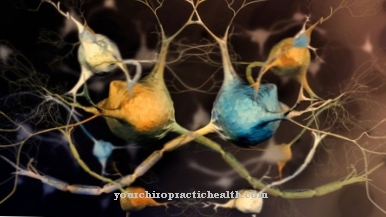A base pair consists of two nucleobases which are located opposite one another in deoxyribonucleic acid (DNA) or ribonucleic acid (RNA), bind to one another and form the double strand with the help of hydrogen bonds. This is the genomic information of an organism and contains the genes. A faulty one Base pairing can lead to mutations.
What is the base pairing?
A base pair consists of nucleobases. It is an element of DNA or RNA. These nucleobases, in turn, together with phosphoric acid or phosphate and deoxyribose, a sugar, form the nucleotide (the base).
Phosphoric acid and deoxyribose are the same for every nucleotide; they form the backbone of DNA. The base and the deoxyribose are known as nucleosides. The phosphate residue means that the DNA is negatively charged and is also hydrophilic; it interacts with water.
Nucleotides differ only in the base. A distinction is made between five bases, depending on whether they are components of DNA or RNA. The bases are adenine (A) and guanine (G), these belong to the purines. Thymine (T), cytosine (C) and uracil (U) are pyrimidines. Purines are heterocyclic organic compounds, while pyrimidines are heterocyclic, aromatic, organic compounds.
In the DNA there is base pairing of adenine and thymine (A-T), as well as guanine and cytosine (G-C). In the case of RNA, on the other hand, a base pairing occurs between adenine and uracil (A-U) and between guanine and cytosine (G-C). This base pairing is called complementary.
The pairings are created by hydrogen bonds. This is the interaction between a hydrogen atom and a lone pair of electrons on another atom. The hydrogen atom is covalently bonded here. This is a chemical bond in which there is an interaction between the valence electrons of one atom and the nucleus of another atom. The base pairs are also used as a measure of the size of the DNA: 1bp corresponds to one and 1kb corresponds to 1000 base pairs or nucleotides.
Function & task
Base pairing has essential functions for the structure of DNA. The DNA occurs as a double helix. The spatial arrangement of the double helix is called B-DNA, a right-handed double-stranded helix which, in contrast to the A-shape, has a more relaxed arrangement.
When adenine and thymine are base paired, two hydrogen bonds are formed. In contrast, the pairing of guanine and cytosine creates three hydrogen bonds. Due to the base pairing between a purine and a pyrimidine, the resulting distance between the two DNA strands is always the same. The DNA has a regular structure, the diameter of the DNA helix being 2 nm. A complete rotation of 360 ° within the helix occurs every 10 base pairs and is 3.4 nm long.
Base pairing also plays an important role in DNA replication. The DNA replication is divided into the initiation phase, elongation phase and termination phase. This happens during cell division. The DNA is unwound by an enzyme called DNA helicase. The double strands are separated from one another and a DNA polymerase attaches itself to a single DNA strand and begins to produce a complementary DNA strand on each single strand.This creates two new single strands of DNA, which form a new DNA double helix.
The structure of the newly synthesized DNA double helix is ensured by the complementary base pairing. In addition, base pairing plays an essential role in protein biosynthesis. This is divided into transcription and translation. During transcription, the DNA double helix is untied and the complementary strands are separated from one another. This is also done by the enzyme helicase.
The RNA polymerase binds to a single strand of DNA and forms the RNA complementary to it. In the case of RNA, uracil is used instead of thymine and, compared to DNA, it has a so-called polyA tail. RNA always ends in a string of adenine. The RNA also remains a single strand and is used to synthesize a protein during translation. The type of protein depends on the respective gene that was read and used as a template for protein synthesis.
You can find your medication here
➔ Medicines for muscle weaknessIllnesses & ailments
Erwin Chargaff found that the number of bases adenine and thymine as well as guanine and cytosine is 1: 1. James D. Watson and Francis Harry Compton Crick finally found out that there is complementary base pairing of adenine and thymine as well as guanine and cytosine. This is known as the Watson-Crick pairing.
However, various disorders can cause unusual base pairing, such as reverse Watson-Crick pairing. Another erroneous form of base pairing is wobble pairing. These are pairings contrary to the Watson-Crick pairing such as G-U, G-T or A-C. These errors can occur during DNA replication and must then be eliminated by DNA repair.
Incorrect base pairing can lead to mutations. These mutations don't have to be harmful. There are so-called silent muations, in which a base pair is exchanged for another pair, but it does not result in any functional or structural disturbances for the synthesized protein. In the case of sickle cell anemia, however, a mutation is the reason for the formation of non-functioning red blood cells. The mutation directly affects hemoglobin, which is responsible for transporting oxygen in the blood. Serious and life-threatening circulatory disorders and anemia occur.












.jpg)



.jpg)










.jpg)
